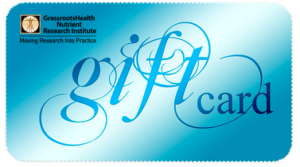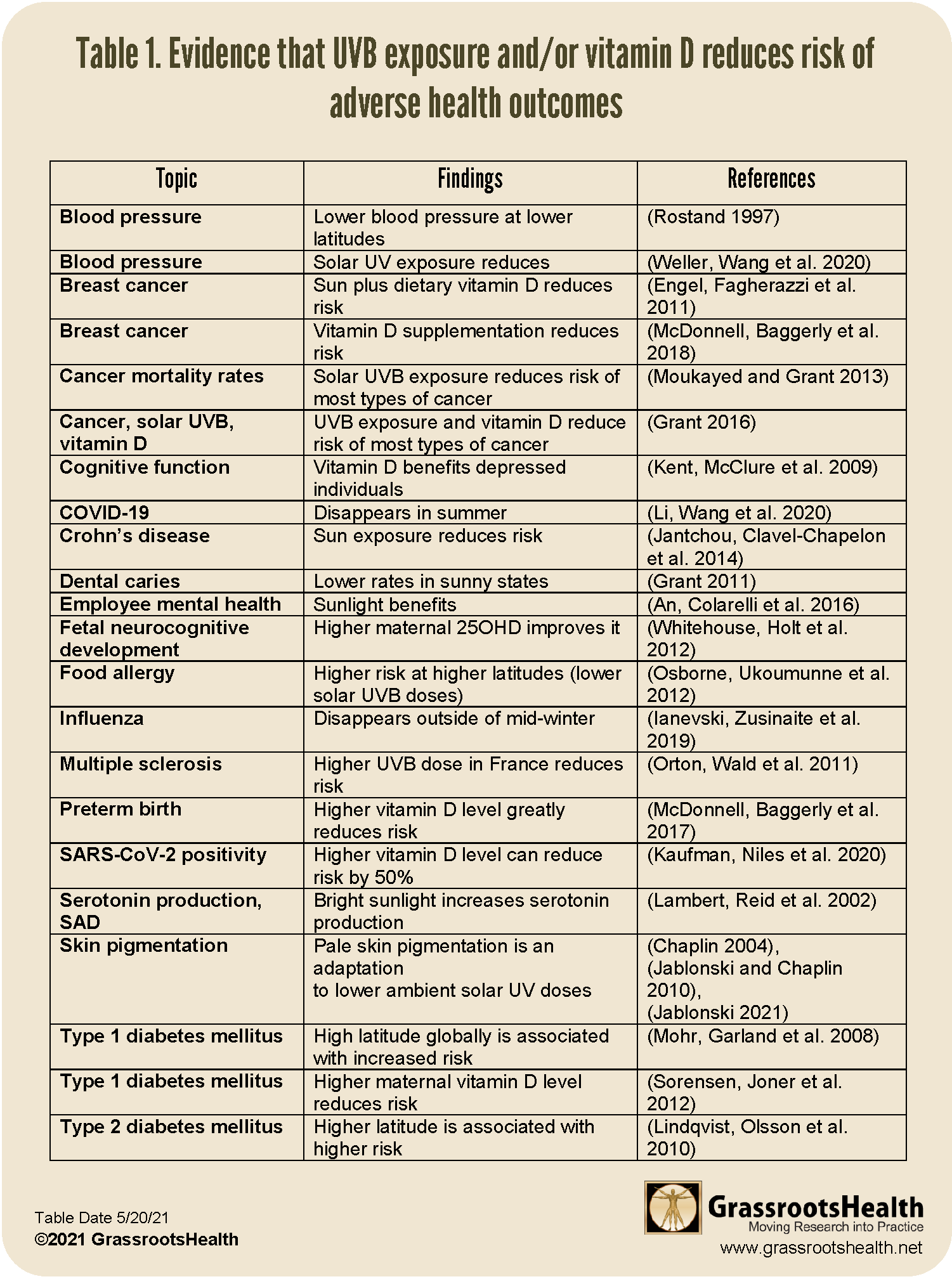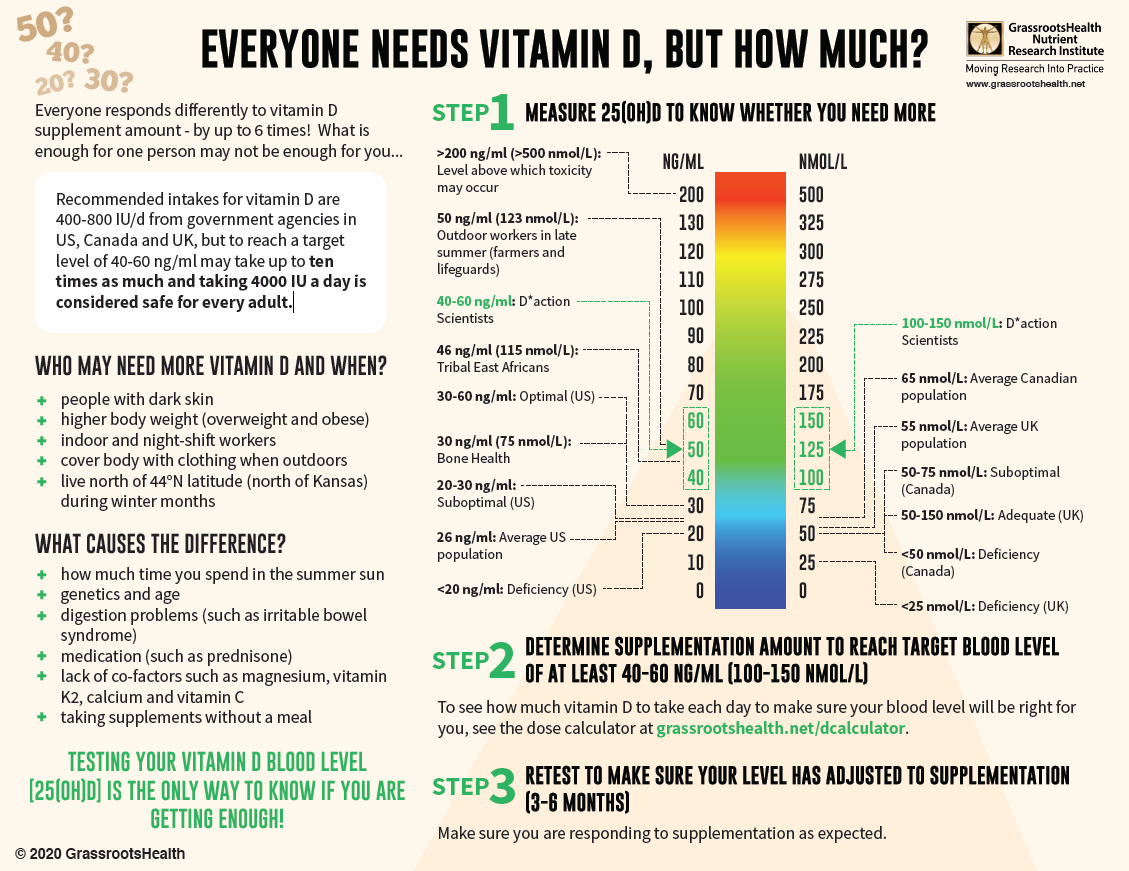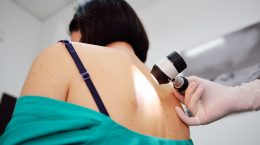Published on May 31, 2021
Review: Sunshine has many benefits for human health, and a deficiency in sunshine can lead to disease
 While 2021’s Sunshine Month may be coming to a close, the information covered remains essential year-round to anyone concerned for their optimal health and wellbeing. As discussed in a recent guest post by one of the world’s leading Sunshine Experts, Dr. William Grant, “The evidence supporting the role of moderate sun exposure and vitamin D in supporting optimal health has increased tremendously during the past two decades,” and while “Sun exposure used to be considered a healthy thing to do,” there is certainly more evidence today demonstrating that the health risks associated with sun avoidance out-weigh any harm that may come from regular, non-burning sun exposure.
While 2021’s Sunshine Month may be coming to a close, the information covered remains essential year-round to anyone concerned for their optimal health and wellbeing. As discussed in a recent guest post by one of the world’s leading Sunshine Experts, Dr. William Grant, “The evidence supporting the role of moderate sun exposure and vitamin D in supporting optimal health has increased tremendously during the past two decades,” and while “Sun exposure used to be considered a healthy thing to do,” there is certainly more evidence today demonstrating that the health risks associated with sun avoidance out-weigh any harm that may come from regular, non-burning sun exposure.
Sunshine Avoidance Can Lead to an Early Death
A study among 30,000 Swedish women by Lindqvist et al. found that “smokers in the highest sun exposure group were at a similar risk as non-smokers avoiding sun exposure, indicating avoidance of sun exposure to be a risk factor of the same magnitude as smoking.” He went on to conclude that, “Guidelines being too restrictive regarding sun exposure may do more harm than good for health.”
A 2020 review of studies on the health effects of sunshine by Alfredsson et al. indicated that 340,000 deaths per year in the United States and 480,000 deaths per year in Europe, as well as a rise in many diseases, could be attributed to insufficient sun exposure. These diseases include cancer (especially breast and colon cancer), hypertension, cardiovascular disease, metabolic syndrome, multiple sclerosis (MS), Alzheimer’s disease, autism, asthma, type 1 diabetes, and myopia. While the health concerns may be due to a resulting deficiency of vitamin D from a lack of UVB from sunshine, they could also be attributed to an inefficient release of nitric oxide from sun exposure and other physiological benefits from the sun and its wide range of solar radiation.
Sunshine Benefits Our Health in Many Ways
Below are some of the published health benefits from sunshine covered by the authors or previously covered by GrassrootsHealth:
Decreased Risk of Breast Cancer
Long-term occupational UV exposure was associated with a reduced risk of late-onset breast cancer among Danish women, with longer durations and higher amounts of UV exposure contributing to a further decreased risk. This study found a 17% decreased risk for late-onset cancer with longer duration of UV exposure, and an 11% decreased risk with higher cumulative UV exposure. The researchers also found a 15% decreased risk overall associated with longer duration of UV exposure for all diagnosis ages combined.
The authors of a separate meta-analysis found a significant dose-response correlation between UV exposure and breast cancer risk such that women in the highest exposure groups had a 30% lower risk of breast cancer compared to women in the lowest exposure groups.
Lower Risk of Colorectal Cancer
This study found a 19% lower risk of colorectal cancer for participants who reported sun exposure of 2 or more hours per day compared to 1-2 hours per day in the prior summer, and that sun exposure and dietary vitamin D, both separately and together, could reduce colorectal cancer risk and be key to cancer prevention.
Lower Risk of Cardiovascular Disease and Hypertension
Research suggests that avoidance or lack of sunshine may be a risk factor for increased blood pressure and death from heart attacks. In fact, a large cohort study found that, compared to those with the greatest amount of sun exposure, women with low sun exposure habits had a 41% higher risk of hypertension, and women with moderate sun exposure habits had a 15% higher risk.
Improved Cognitive Function
Researchers found that participants in the high sun exposure group had higher average mental state scores of cognitive function compared to participants in the medium or low exposure groups. This study concluded that long-term high sun exposure throughout life could reduce the risk of cognitive impairment in the later years of life.
Decreased risk of Multiple Sclerosis (MS)
Researchers have found that people living in high UVB areas before the onset of MS had a 45% lower risk of MS compared to those living in low UVB areas, and those who spent 10 or more hours per week outdoors in the summer in high UVB areas during ages 31-40 had an 82% lower risk of MS compared to those who spent less than 10 hours per week outdoors in low UVB areas. Other age groups also showed a decreased risk. Additional research has found that those with the highest lifetime UV exposure in the winter had a 50% lower risk of MS compared to those with the lowest, and that higher lifetime UV exposure was associated with a 47% lower risk of MS in African Americans, a 32% lower risk in Caucasians, and a 34% lower risk in Hispanics after adjusting for vitamin D level, indicating sunshine has additional benefits for MS beyond vitamin D.
Diabetes Incidence is Associated with Latitude
Studies have shown an association between UV exposure, vitamin D, nitric oxide, and the suppression of metabolic syndrome and diabetes development. In fact, higher rates of type 1 diabetes and several cancers are observed in the far northern and southern latitudes – locations that have lower UVB irradiance from the sun.
Improved Immune Health and Lower Risk of Viral Infections
The incidence of infectious disease has been related to several factors, including season, temperature, humidity, and UV radiation, with certain respiratory illnesses such as the flu being especially known to increase during specific months or seasons. Some studies have also revealed a beneficial association between higher ambient UV levels and lower rates of COVID-19 deaths. A study of the 1918 flu found a general trend with lower rates of pneumonia as a complication of influenza and influenza fatalities for those locations at lower latitudes within the United States.
Asthma, Lung Development, and Eczema
While research has shown a relationship between vitamin D levels and asthma, some studies mentioned by Alfredsson et al. indicate a positive correlation between an increased incidence of asthma and latitude and an association between the lung development of newborns and UV exposure of the mother. Other findings include a reduction of about 50% in the development of eczema among children exposed to higher doses of UV radiation.
UVB May Benefit Myopia
Myopia, or short-sightedness, may increase the risk of retinal detachment and blindness. Several studies mentioned by Alfredsson et al. have indicated a reduced risk of myopia with increased UVB exposure, especially during childhood and young adulthood.
Additional Health Benefits from Sunshine and UV Exposure:
- Reduced Risk of Inflammatory Bowel Disease
- Improved Infant Motor Development
- Lower Risk of Childhood Learning Disabilities
- Decreased Cancer Risk
- Improvement in the Intestinal Microbiome
- Better Mood
- Improvement in Skin Disorders
- Decreased Risk of Melanoma
The table below lists a few more, as provided by Dr. William Grant in his recent guest blog, “The Health Benefits and Risks from Moderate Sun Exposure.”
Click to Enlarge & Print
Full list of References Here
What About Skin Cancer?
According to the American Cancer Society, a vast majority of skin cancers are non-melanoma skin cancers, with basal cell carcinomas (BCC) accounting for approximately 80% of cases and squamous cell carcinoma (SCC) ~20%. These non-melanoma skin cancers usually grow slowly, rarely spread to other parts of the body, and are very treatable.
Despite public health messages to the contrary, not all skin cancers, particularly melanomas and basal cell carcinomas, are directly attributable to moderate sun exposure. Though painful sunburns before the age of 20 seem to be a strong predictor of all types of skin cancer, chronic or lifetime sun exposure has been associated with an increased risk of SCC but a decreased risk of BCC and melanoma.
When it comes to skin cancer, intermittent, or sudden, drastic exposure to high intensity sunlight, especially resulting in a burn, is more likely to result in local DNA damage which can increase risk over time, compared to regular, moderate, non-burning exposure to sunshine.
Are you getting enough sunshine? Test your vitamin D to find out!
Instead of choosing to avoid sunlight, learn how to use it to your advantage and avoid the Diseases of Darkness associated with a deficiency of sunlight and vitamin D. Measuring your vitamin D level is one way to tell if you are getting enough healthy sun exposure, or if you may need more. Test your vitamin D level today!
Measuring your vitamin D level is one way to tell if your body is getting enough sunlight, and correcting a vitamin D deficiency at any age and any time of life can decrease potential disease severity and improve outcomes. With almost 90% of the general population having vitamin D levels below the recommended 40-60 ng/ml (100-150 nmol/L), it is obvious that most people need more vitamin D. While most of us cannot achieve a vitamin D level of 40-60 ng/ml from sun alone, either due to our lifestyle, where we live, or other circumstances, we can certainly reach those levels with the right amount of supplementation.
Below is a guide for how much you might need, and who may need more. Your levels can be tested safely at home – order your home test kit today.
By joining the GrassrootsHealth projects, you are not only contributing valuable information to our study, but you are also gaining knowledge about how you could improve your own health through measuring and tracking your nutrient status, and educating yourself on how to improve it. Do you know what your status of vitamin D, omega-3s, and other essential nutrients is? Could your levels be improved? Test now to find out!
 We now have a NEW GIFTING SERVICE that allows you to quickly send ‘Gift Cards’ to friends, family and coworkers who you consider might need immediate access to testing, and to Claim the Joy of Your Health TODAY. Give the gift today!
We now have a NEW GIFTING SERVICE that allows you to quickly send ‘Gift Cards’ to friends, family and coworkers who you consider might need immediate access to testing, and to Claim the Joy of Your Health TODAY. Give the gift today!








